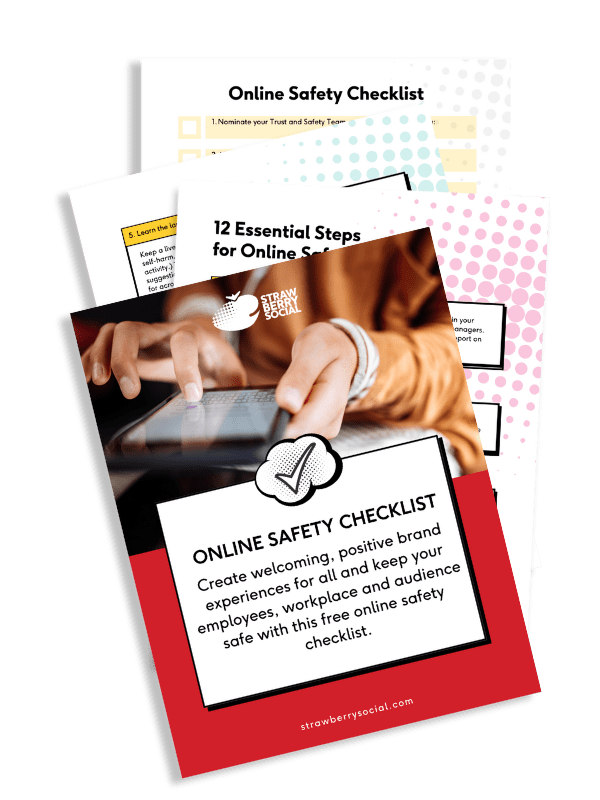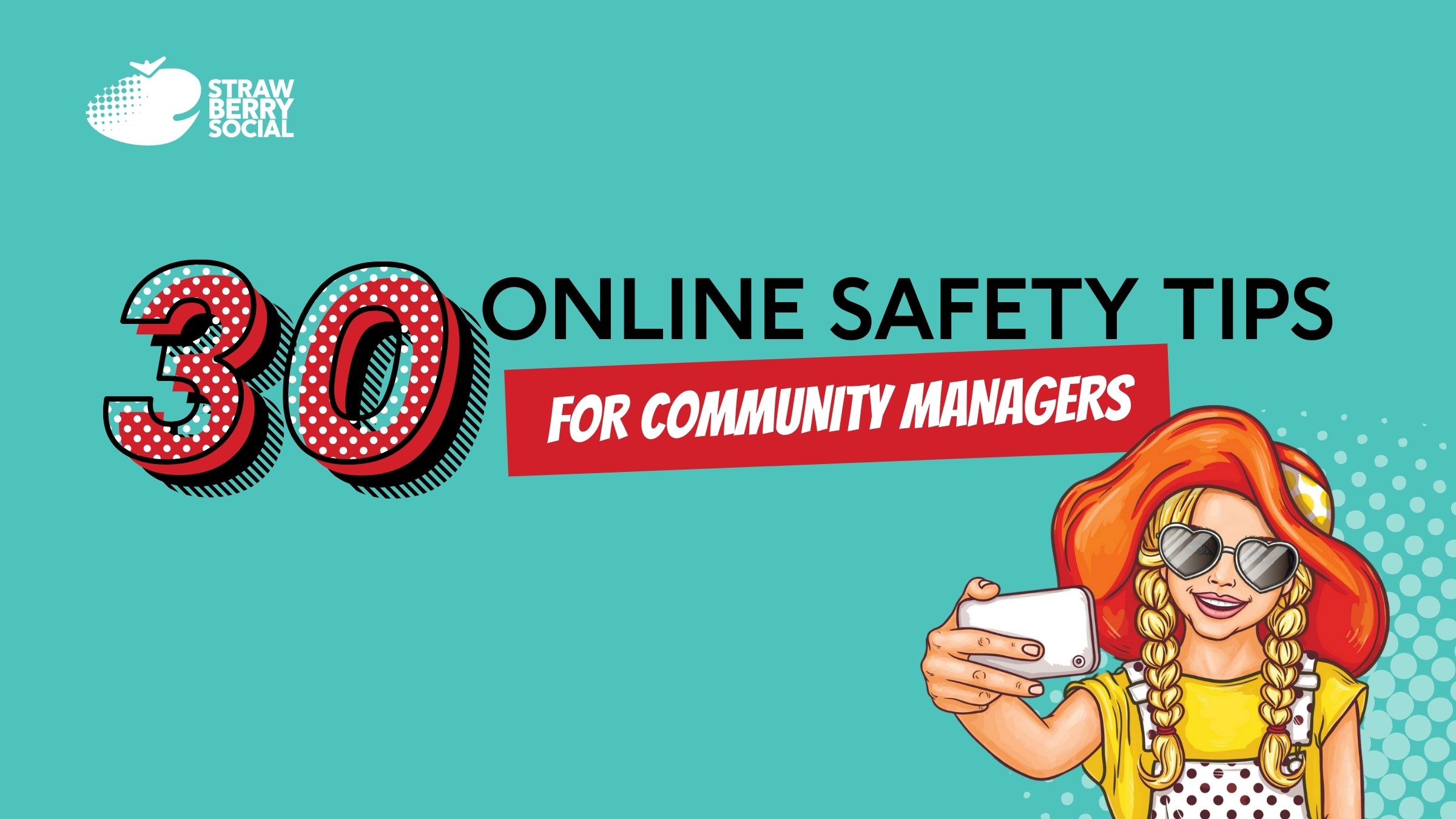As a specialist content moderation agency, we understand the challenges community managers face in protecting their audience from harmful content and interactions. To help you navigate the complex landscape of online safety, we’ve compiled 30 essential online safety tips to help you to foster a secure, thriving community. Read on for strategies honed from years of experience, ensuring your online spaces remain positive and safe for everyone.
1. Nominate online safety champions
Give online safety a face by appointing key members of your Marketing, Social Media, IT and PR teams as champions. That way, people know who to contact and the public knows you take Safety seriously.
2. Publish your online safety policy
Create a clear and concise online safety policy, then publish it somewhere highly visible. Make sure it’s written in plain English and is accessible for everyone. Review your policy on a regular basis and update it as needed.
3. Identify potential risks
Does your audience include high-profile individuals, vulnerable adults or children? Consider problematic topics that could come up and create responses for each one.
4. Protect employees
Share online safety tips and tools with employees so they know how to lock down their personal channels and avoid becoming victims of online harassment, a swatting attack or doxing.
5. Monitor activity
Assign specific people to keep up to date with the news cycle and report back on any relevant conversations taking place online. Update your Moderation and Safety teams about any news pieces or cultural changes which may affect their day to day work.
6. Look out for language
Keep a list of keywords of concern such as suicide, self-harm and violence. Search sites like Urban Dictionary for acronyms and slang terms, then set up alerts and monitor daily.
7. Seek help from professionals
If you need help to spot signs of grooming, scamming or violence there are professional moderation agencies with online safety expertise like StrawberrySocial, who can provide assistance.
8. Set community guidelines
Create a set of rules for community members and enforce them consistently. Be clear on what help you can provide and at what point you’ll signpost them to support elsewhere.
9. Follow through on policies
Set policies around the removal of content and/or community members, and follow through on these. Always provide transparent explanations for the actions you’ve taken to maintain community trust. But honour user confidentiality.
10. Incident reporting
Establish clear procedures for reporting online safety incidents and ensure there’s a swift and coordinated response to minimise potential damage. Make employees aware of the process too.
11. Protect the privacy of your community members
Advise against community members sharing identifying information where possible. Always encourage them to direct message you any personal details and explain why, so they know you value their privacy.
12. Get to know your community
Keep an up-to-date list of your online advocates including celebrities, influencers and supportive community members. Set up alerts to monitor mentions of them on a daily basis.
13. Embed online safety in your campaigns
Before launching a campaign or product, run it past your Online Safety team. They can share any concerns and prepare for possible comments. Ask colleagues to sense-check the content too.
14. Monitor audience behaviours
After launching a campaign or product, monitor reactions and note if something provokes a response you weren’t expecting. Remember to allocate budget to customer engagement, conversation monitoring and safety.
15. Create an online safety hub
Build a library of all your online safety resources including agreed messaging, guidelines and key contacts. Make sure it’s accessible for all employees and keep it up to date.
16. Review and inform
Look back at past online safety incidents and capture any learnings. Log what response you posted and use that to inform the team in case of any future occurrences.
17. Stay up to date
Stay on top of the latest online safety trends and best practices. Signing up to our newsletter is a great way to keep abreast of the ever-changing online safety landscape.
18. Teach digital literacy
Educate your audience, especially younger users, about responsible online behaviour and critical thinking. Take a look at our jigsaw effect infographic for more info.
19. Use reputable sources
Verify the authenticity of information you find before sharing it with your online community, to prevent the spread of misinformation.
20. Highlight success stories
Share success stories and positive impact to inspire your audience. Focus on uplifting content to foster and maintain a positive online presence.
21. Monitor comments and messages
Actively monitor comments and direct messages on your social media platforms to address any questions or concerns and filter out inappropriate content.
22.Educate your supporters
Provide your followers with key, digestible online safety tips and encourage them to practise responsible online behaviour when engaging with your organisation’s content.
23. Collaborate responsibly
Assess organisations or influencers carefully to ensure they align with your values and principles before collaborating. Our Influencer Vetting service helps you make smart decisions about who you work with.
24. Build a supportive community
Develop a supportive online community and foster a culture of positivity and inclusivity. Encourage your followers to respect each other, champion other members and report any inappropriate behaviour promptly.
25. Train and empower your moderators
Provide your social media moderators with training on your community guidelines, moderation tools and processes, to equip them with the resources to effectively manage online interactions, including escalation procedures.
26. Use AI moderation tools with caution
Social media moderation tools and AI can make things easier and more efficient for your moderation team. However, ensure the use of moderation tools and AI is always overseen by experienced, human moderation professionals.
27. Address misinformation and harmful content promptly
Establish clear procedures for identifying, reviewing and addressing misinformation and harmful content on your social media platforms. Prioritise removing or flagging inappropriate content to protect your followers.
28. Collaborate with other organisations
Partner with others in your field to address common online safety challenges. Share best practices and exchange information to promote a safer digital environment. Check out our Online Safety Resources.
29. Look after your moderators
Moderating content on social media is a relentless, tough job. Some aspects of the job are likely to have a negative impact on your moderators’ wellbeing. Giving them the support and recognition they deserve can really help.
30. Review your policies regularly
It’s important to review social media policies and practices regularly so they remain effective. Keep an eye on emerging trends and threats, as well as feedback from followers.

FREE ONLINE SAFETY CHECKLIST
Grab your free online safety checklist and take action to protect your brand and communities online.
This free resource has been developed by online safety experts and professional moderators to help you:
- Create welcoming, positive brand experiences
- Keep your employees, audience and online communities safe
- Put online safety at the heart of your digital campaigns



 May 21, 2024
May 21, 2024  Share This Post
Share This Post